Is it just the size of your business or organisation that determines the likelihood of workplace falls?
Is it only the type of work your staff perform that makes the difference?
Are consulting businesses free from risk?
Do only large construction businesses need to put in appropriate controls?
Where only a small business, we don’t need to worry about falls in the workplace.
Safe Work Australia compiles the Work-related Traumatic Injury Fatalities data set, which provides national statistics on all workers and bystanders fatally injured at work. The key statistics report for 2021 indicates that 20 per cent of workers are injured from falls from heights or being hit by falling objects. See the Report here.
Workplaces
Consulting or Business Services
There is a risk of falls in every business.
Regardless of the size of your business, for example, a consulting or bookkeeping business.
Even if the workplace is a standard office, then there’s the opportunity for people to slip over, slip up and down steps, trip over items, and wear and tear on carpets and items like that.
Warehouse of Workshop
Now, you have more opportunities if you’re a more significant business or have a warehouse or a workshop.
Workers can leave items on the ground, such as tools and materials.
Other items left lying around, such as plant, equipment, or parts pulled from a vehicle or machinery.
Oil and water can be split on the ground.
Manufacturing
Larger businesses, such as manufacturing, can have multiple opportunities for falls. These can include overhead and jib cranes.
Second-storey levels or mezzanine floors can be problematic. Frequently there is no plinth installed around the base, or containers are stacked up and not protected from falling.
What is the problem if there is no plinth around the base of the floor?
The lack of protection allows someone to kick an item that falls over the top and hits someone on the head.
Construction
Now let go to that next level of fall where someone’s working on a ladder or needs to replace or maintain something, replace a light globe. Or it could be someone in the construction space which is working on a ladder.
Daily workers, such as painters, electricians, and builders, will have various means and ways to fall from heights.
Tradies could be working on a ladder, elevated work platform, scissor lift or scaffolding.
The next level is to work on a roof above that two or three meters high.
In this scenario, you should have a safe work method statement to help ensure that you’ve considered all the control measures needed.
You might need to wear a harness if working on a roof.
It may be more appropriate to install edge protection.
So the risk of falls in any workplace can vary from tiny, insignificant hazards such as slips, trips, and falls, for example, to the point where you’re working on the roof.

Managing the Risk of Falls Code of Practice
So how do you manage the risk of falls?
The first step is to identify the requirements for your industry.
The place to start is to review the Code of Practice for Managing the Risk of Falls published by Safe Work Australia or Safe Work New South Wales.
The code of practice provides some very clear methodologies to help you manage risks in the workplace or those hazards in the workplace.
So that’s the first step.
Once you’ve got an identify the code of practice, you then need to conduct a risk assessment to identify those areas where falls are more likely to occur.
So as I said earlier, it could be simple, or it could be more extensive.
SafeWork NSW has published a checklist.
SafeWork NSW inspectors regularly blitz construction sites to check compliance and talk with employers and workers about how to work safely at heights. Use this checklist to find out if your construction site is working at heights safely.
Consultation
Walk Around the Workplace and Talk to Workers
So the critical thing to do then is to wander around the facility. Talk to your staff, remembering that consultation is critical to managing risks in your workplace.
You will pick up more information if you ask your workers what the risks in the workplace are.
It’s pretty simple.
Too often, organisations, supervisors or managers are afraid to ask workers because they’ll get the truth.
Reasonably Practicable
Now when it comes to providing a safe workplace, we need to do everything reasonably practicable to reduce the likelihood of an incident occurring.
The next step is to consult with your workers.
Don’t be afraid to consult with workers.
Even better, include your workers in inspections and reviews of the workplace as part of a team. For those of you who are aware of seeking certification to ISO 45001, you will understand that this will assist you with your requirements for participation.
So how do we consult with workers in the workplace?
Simple. Ask your workers what’s going on.
If we get workers to participate in risk assessments and safety walks, they better understand why they are carried out.
If they understand the why hopefully, we can promote a culture where they can help identify those risks and hazards in the business in the future.
Suppose they can identify the hazard before someone gets hurt and take action to reduce the likelihood of the hazard occurring. In that case, it can reduce injuries to workers and cost to the business.
So not complex, but have a look at the code of practice.
You need to make sure you do your risk assessments. Review the standard article for further information
Risk of Falls Safe Work Procedures
It is everyone’s responsibility in the workplace to report hazards as we find them.
Where possible, we need to eliminate the hazard first; if not, the next step is to isolate or control the fall risk.
If there are no other options and it is still safe to do so, then we need to have appropriate safe work procedures in place to ensure that workers have been trained.
Once the safe work practices have been implemented, the next step is ensuring that the workers are doing things correctly and safely.
Remember that if they’re working above heights, above two to three meters, depending on the jurisdiction in which that particular organisation works, you will require a safe work method statement.
The safe work method statement should be clear about how we manage risk or the risks in that particular environment using those methods such as ladders, elevated work platforms and working on the roof.
The next step is that once we’ve got those safe work procedures in place, we need to ensure that we’ve trained people to operate or do those particular tasks safely.
Identifying Staff Reducing the Risk of Falls
So they’re operating and doing things safely to reduce the risk when we’re supervising by doing a safety walk, making sure that we’re clear that the staff or workers, implementing those particular procedures where they need to be.
The other factor is ensuring you’re conducting regular workplace reviews or inspections.
So are we going around from time to time to check to ensure those items or there’s no particular plant and equipment damaged?
We need to check that some plant and equipment items don’t have leaks.
Check no fluid or chemicals are leaking on the ground.
For example, have new chemicals been purchased?
Has a risk assessment been completed?
Has no one bothered to ensure that there are trays underneath the chemicals to stop the spill of the chemical falling on the ground?
Has the area been appropriately bunded to reduce the likelihood of an environmental issue?
Consequences of Falls from Heights
If no control measures are in place to prevent a fall from heights and an individual is involved in a fall, it can result in:
- Death
- Head Injuries
- Fractures and contusions
- Severe permanent injury, e.g. paralysis
According to Safe Work Australia, between 2003 and 2015, 359 workers were killed following a fall from heights incident. Over 50% of these resulted in a fall from less than 3m.
- 28% of fatalities in Australia were caused by a fall from a height in 2015.
- Ladders caused 30% of serious claims for falls from a height (read more in the Construction industry profile)
- 48% of fatalities in the construction industry were from falls from a height of less than 4 metres.
The most significant number of fatalities involved falling from roofs (59), ladders (54), vehicles (27) and horses (33).
Workers aged 45 years and over made up 65% of those who died.
The construction industry accounted for 37% of fall-related fatalities.
What does this mean? The construction industry is not the only place workers get hurt.
Click here to read more about this in the Construction industry profile from SafeWork Australia.
Working at Heights Procedures
Restrictions
Check if your organisation has a policy that no staff member will work at a height above the use of a ladder or internal access systems.
If work is required above this height, a specialist contractor and equipment will be engaged to undertake this work after a risk assessment.
Risks Associated with Falls and Working at Heights
When working at heights, there are two significant risks associated.
- Falling risk for workers working at heights
- A risk is that a person or object may fall and hit someone working below
An organisation needs to take consideration when dealing with heights work keeping these significant risks in mind.
When are workers exposed to a Fall Risk?
Fall risks are not always a result of working at extremes of height on ladders and scaffolds etc.
Risk of falls can occur from minor works, including.
- Climbing on top of trucks or loads.
- Working near trenches or pits.
- Working from an unprotected roof edge.
- Climbing on top of plant or machinery.
Ladders
It is essential not to overlook the risks ladders can present when being used. Ladders can be a significant cause of injuries throughout the workplace.
Before using a ladder, ensure it is appropriate to do so. Ensure the ladder is suitable for the application.
3 Points of contact
To use a ladder safely, ensure there are always 3 points of contact, meaning two feet, one hand or two hands and one foot in contact with the ladder at all times.
Exceptions are only for dismounting the ladder onto the ground or a stable surface.
Inspections
The ladder requires frequent inspections to ensure safe use. It is essential to inspect the following:
- Missing or loose steps
- Loose or faulty spreaders
- Condition of rope
- Safety feet are solid
- Rubber grips are in good condition
If any of the above is faulty, do not use the ladder until it is repaired.
Want to learn more about Ladder inspection Click here

Harnesses
Operators are also required to inspect their equipment before and after each use.
All equipment must be inspected by a height and safety inspector as per AS/NZS 1891.4: 2009 every six months or per company procedures.
Before use, ensure you inspect the harness yourself for any irregularities with any of the following:
- Harnesses
- Lanyards
- Slings
- Rope grabs
- Pole straps
- Ropes
If any of the above are found to have faults, do not use them until repairs or equipment replacement has been completed.
Want to learn more about inspecting your harnesses, click here.
If you require more information or need an inspection done on your harnesses, don’t hesitate to contact Newcastle Rescue at 1300 356 686 or www.newcastlerescue.com.au.

Managing Risks of Falls
The most effective way of minimising the risk of falls is to eliminate the need to work at heights.
Where possible, work can be conducted without risk if alternate ways of completing the tasks are available.
Alternatively, fall prevention devices need to be implemented into work being conducted at heights. These devices need to be such that workers don’t need to adjust or move them once they are in place. Examples include
- Guard rails or barriers
- Fixed or temporary work platforms
- Travel restraint devices
- Fall protection covers
- Elevated work platforms
- Fall Restraint Systems
- Fall arrest systems
- Edge protection
Working at Heights Checklist
Before work at heights can be conducted, the working at heights checklist must be filled out accordingly.
This checklist can be copied in CIRT under ” Safe Operating Procedures “Working at Heights SOP_0016.
Filling out this checklist will ensure all the plant and equipment used when working at heights is up to date and fully operational.
If equipment is suspected to be broken or malfunctioning, DO NOT proceed with work. Report to a supervisor or manager, and seek alternate arrangements.
Safe Work Method Statement
A PCBU must provide workers with the relevant SWMS before work can commence. SWMS will ensure the workers know exactly how to work at heights to reduce the risk of falls.
As defined in WHS Regulation 291, Safe Work Method Statements are required for work involving a risk of a person falling more than 2 meters. Examples include:
- Installing an evaporative cooler on the roof of a house.
- Installing roof trusses.
- Installing roof tiles or roof sheeting.
- Working adjacent to a pit or opening with a fall height of more than 2 meters.
Work carried out in or near a shaft or trench with an excavated depth greater than 1.5 meters or in or near a tunnel.
Examples include:
- Laying or repairing pipes or conduits in a trench more than 1.5 meters deep
- Testing drainage pipes in a trench more than 1.5 meters deep
- Working near bored piers greater than 1.5 m deep
- Building a tunnel in the course of constructing an underground railway or road
If you require or are unsure whether you need an SWMS for Working at Heights, don’t hesitate to contact CHD Partners for further information.
Incident Reporting
All incidents, regardless of injury or near misses, must be reported. Just because someone is not injured doesn’t mean the incident shouldn’t be recorded.
It is essential to gather information and the cause of the accident. It is also the responsibility of management to investigate all incidents to identify the cause and how to prevent similar incidents occur further.
Reporting is completed by filling out an incident report form. For CIRT uses, you can go to Documents, Forms and then click on the Incident Reporting form.
Safe Storage on Shelves
Follow these practices when storing materials on shelves to reduce the risk of falls.
- Store heavy containers no lower than the second shelf from the floor to minimise the risk of back injuries.
- Small, light and infrequently used items are stored on upper shelves.
- Use a stool or step ladder to place or retrieve materials from upper shelves. Do not use a chair, table, etc., as a step.
- Do not use the bottom shelf as a step.
- Do not stack items on top of each other on top shelves.
Racking Design and Layout
Any racking used in the workplace should be designed specifically for the size, shape and weight of the products being stored.
It is essential that all racking is set up and maintained according to the manufacturer’s instructions.
The racking layout should be compatible with the material handling equipment used in the workplace – e.g. aisle width should match the turning circle of the forklift used for picking and replenishment.
The layout should also consider emergency access, adequate lighting, and manual handling activities.
Want to know more about Inspecting Pallet racking Click Here.
For further information about racking, refer to the WorkSafe NSW website.

